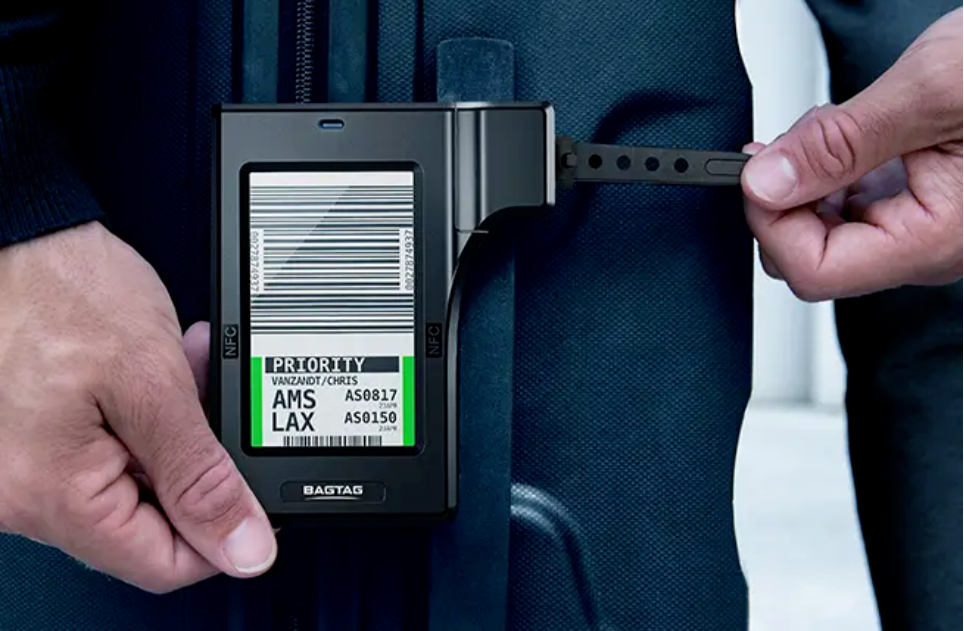Quadrant Lab, in collaboration with the ePaper Industry Alliance (EPIA) has launched the Quadrant.ePaper weekly bulletin, aiming to provide readers with insights on global industry innovations and the latest news on the ePaper industry and connecting the global IoT ecosystem.
01 Several Airlines Provide ePaper Baggage Tags for Passengers During Thanksgiving Holiday

Several airlines are now providing ePaper baggage tags to passengers during the Thanksgiving holiday, helping them accurately track their luggage during the busy travel season. Eurowings and Icelandair, both subsidiaries of Lufthansa, are among the latest airlines to adopt ePaper baggage tags. Alaska Airlines has been testing ePaper baggage tags with frequent travelers with a plan to expand the service to more passengers.
These ePaper baggage tags, introduced by BagTag, a company based in Amsterdam, the Netherlands, in 2014, are adopted by these airlines. Passengers can obtain them from the airlines or purchase them themselves. The device features an ePaper display embedded with low power Bluetooth (BLE), near-field communication (NFC), and UHF RFID functions. BagTag’s backend system is integrated with the airlines’ systems, allowing passengers to check in their luggage before leaving home and displaying passenger, flight, and destination information on the ePaper display.
02 TopJoy Has Discontinued the Butterfly DES eReader

TopJoy has confirmed that they will not continue to fulfill the orders for 6-inch or 7.8-inch Butterfly eReaders using DES (Display Electronic Slurry) ePaper screens. As of September 2022, TopJoy had raised over $668,000 for these products on Kickstarter. While TopJoy claims to have shipped hundreds of units, some early supporters have reported not receiving any products.
DES is a new type of ePaper technology. It is reported that Laibao Hi-Tech has obtained the rights to DES technology from Wuxi Vision Peak and will invest $1.2 billion in constructing a DES ePaper display production line in the Nanxun Economic Development Zone in Huzhou, Zhejiang Province. This production line will cover complete production processes including driving backplanes, reflective color films, infusion, boxing, assembly, and integration with touch display. Laibao Hi-Tech has previously stated to investors that they have successfully produced multiple ePaper products using DES technology, pending for client validation and promotion.
TopJoy Butterfly is a fully functional and highly portable color eReader that supports Android 11 system. It is equipped with a true-color DES ePaper, offering both 300 PPI monochrome display and 150 PPI color display modes. The 7.8-inch TopJoy Butterfly also comes with a stylus pen with an eraser.
TopJoy stated that they have already exhausted the funds raised in their previous crowdfunding campaign and still have no major customers willing to purchase their hardware solution. Therefore, they will not fulfill the remaining orders for 400 devices.
03 ePaper Helps Scientists Reveal the Secrets of Octopus Camouflage

It is well-known that octopuses can change their appearance in a matter of milliseconds, blending seamlessly with their surroundings. Chameleons pale in comparison to octopuses in terms of speed and accuracy. Now, scientists are developing tools to study the brain activity and skin cells of octopuses, hoping to understand how they have evolved such complex behavior. ePaper technology is also being applied by scientists in the study of octopuses.
Tessa Montague, a molecular biologist at the Zuckerman Institute at Columbia University in New York City, and her colleagues have created a water tank wrapped in ePaper screens. Similar to eReaders, this water tank can change color and appearance through programming, allowing the team to systematically study the octopus’s response to its environment without disorienting the animal, as would be the case with LED or other light-emitting screens.
04 Making ePaper Photo Frames More Colorful

Wolfgang Ziegler has created a color ePaper photo frame for sharing photos taken with smartphones. He combined a seven-color ePaper display, a spare Raspberry Pi, and a frame to create a color ePaper photo frame, using Pimoroni Ink library to display images. Ziegler set the refresh interval to 15 minutes to eliminate the impact of the 30-second refresh time so to achieve a better user experience.

E Ink’s Spectra 6 full-color display technology, launched this year, has significantly improved color gamut and refresh rate compared to previous models. In the future, color ePaper photo frames and similar applications will gradually be introduced, bringing users a more stunning and realistic visual experience.
References:
https://www.nature.com/articles/d41586-023-03558-6
https://hackaday.com/2023/11/21/a-colorful-take-on-the-e-ink-photo-frame/









